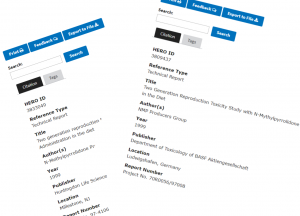Richard Denison, Ph.D., is a Lead Senior Scientist.
Readers of this blog will know how concerned EDF is with ensuring the public’s right to know about chemicals to which they may be exposed. We have repeatedly sounded the alarm when EPA has taken steps to deny public access to chemical information, whether for chemicals entering the market or those already in commerce. Even in recent months, EPA has sided with chemical companies in denying access to health and safety information on chemicals EPA is assessing under the Toxic Substances Control Act (TSCA).
So we were pleasantly surprised by a letter to an industry group that EPA posted on Friday.
 The letter is to the NMP Producers Group, comprised of three companies – BASF, Ashland, and Lyondell Chemical – that make the chemical N-methylpyrrolidone, one of the first 10 chemicals EPA is reviewing under TSCA. Last year, those companies offered EPA a deal they thought EPA would jump at: access to two unpublished studies (see here and here) the companies had conducted, in exchange for EPA committing to deny the public access to the studies.
The letter is to the NMP Producers Group, comprised of three companies – BASF, Ashland, and Lyondell Chemical – that make the chemical N-methylpyrrolidone, one of the first 10 chemicals EPA is reviewing under TSCA. Last year, those companies offered EPA a deal they thought EPA would jump at: access to two unpublished studies (see here and here) the companies had conducted, in exchange for EPA committing to deny the public access to the studies.
Mind you, the companies wanted EPA to rely on their studies in deciding whether or to what extent NMP presents unreasonable risks to health or the environment. This is a chemical EPA examined starting in 2013 and concluded its use in paint strippers presented such high risks that it proposed banning or severely restricting that use of the chemical. (Unfortunately, under the Trump administration EPA abandoned that proposal, instead saying it would start over and reassess NMP through the current risk evaluation.)
A similar situation arose last year for the chemical Pigment Violet 29; in that case EPA initially provided the public only with industry-prepared summaries. After an outcry ensued, EPA negotiated with the industry to release some of the studies – though it still withheld critical data from the key study (see here for details).
So imagine our surprise at the letter EPA posted on Friday. It flatly rejected the NMP Producers Group’s proposal, saying it is counter to the plain language of TSCA, which states that health and safety studies are not eligible for protection under TSCA as confidential business information (CBI). It rejected a tortured reading of TSCA proffered by the industry group:
Contrary to the Group’s suggestion, a specific exercise of TSCA authority is not required for a submission to be deemed “submitted under” TSCA for these purposes. See 40 CFR 2.306(b). EPA has authority to require the submission of these studies under Sections 8 and 11(c) of TSCA. Irrespective of whether the group submits the studies to EPA on its own accord, or EPA obtains the studies in some other manner, a CBI claim under TSCA for the health and safety information contained in these studies is likely to be denied in light of the limitations in TSCA 14(b)(2).
EPA went further, saying that TSCA calls on EPA to make “sufficient information” it relies on in its risk evaluations available to the public “to allow for meaningful and informed comment.” EPA noted that it would almost certainly be required to release the studies if requested to do so under the Freedom of Information Act (FOIA).
EPA also rejected two half-measures proposed by the industry group – which were the same as those the PV29 data owners had suggested last year: Providing selective access to the studies in a public reading room at EPA’s offices, subject to viewers being restricted from copying the studies; and having the public rely on summaries of the studies in lieu of access to the full studies. Neither of these comport with TSCA, let alone satisfy the public right to know.
EDF and other health and environmental NGOs have been making similar points for months; see here, here and here.
Finally, the EPA letter appropriately noted that:
EPA is not in possession of complete, unredacted versions of the Group’s studies. As such, EPA does not have a basis to judge the quality of the studies through our systematic review process or to assess the conclusions by applying a weight of evidence approach. Nevertheless, if EPA receives complete versions of the Group’s studies, we will make every effort to review and incorporate the information into the ongoing NMP risk evaluation as appropriate, considering the approaching deadlines in TSCA section 6 for completing the risk evaluation. If EPA does not receive complete versions of the studies, we will not consider them in the risk evaluation.
While we agree with these statements, EPA’s actual draft risk evaluation for NMP is somewhat contradictory. In discussing the two industry studies in footnote c on p. 188 EPA states: “Studies not rated because EPA does not have access to the complete study report. These studies are included here because previous assessments have cited them as supporting studies and they contribute to overall weight of evidence.”
As stated in EPA’s letter, it is wholly inappropriate and not scientifically possible for EPA to include studies to which it does not have access in a weight-of-evidence approach. While our examination of the draft risk evaluation suggests EPA did not use the results of these studies in its analysis, EPA needs to be very clear that it will not do so.
In any event, I want to offer rare kudos to EPA for getting something right under TSCA implementation. We can only hope EPA will stick with the position articulated in its letter.









